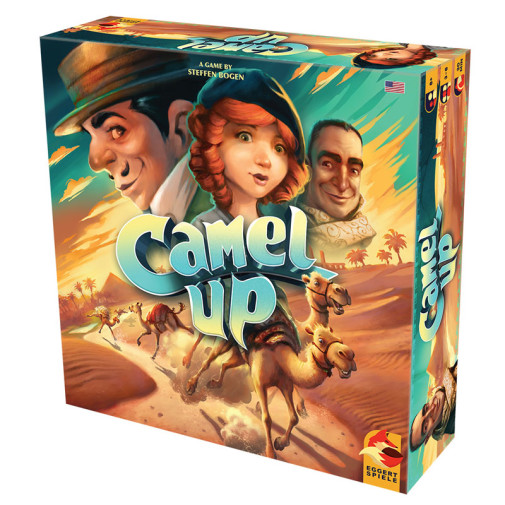We use cookies to make your experience better. To comply with the new e-Privacy directive, we need to ask for your consent to set the cookies. Learn more.
Camel Up Game
- Small parts. Not for children under 3 years.
Does it sound exciting to watch a wacky camel race and bet on the winner? Do you have a fun-filled group of 3 to 8 people who like a light, quick, group experience? Then this is your game! Players need good timing instincts and a keen eye for quickly changing odds in this ever-moving, action-packed camel race to the finish! The player that can most accurately place their bets and collect the most money wins!
Each player takes the role of a spectator to witness five racing camels line up in their starting positions, determined by the roll of the dice that matches their color (blue, red, yellow, green and purple). In addition, another two crazy camels (black and white) start facing the opposite direction on the track and run the race backwards. Each player puts bets on any of the five camels by acquiring betting tickets during each leg of the race and placing finishing cards to guess winners and losers at the end of the race.
Players take turns performing one of four actions. 1.) Take the top betting ticket of any color-matching betting stack to place odds on which camel will win the current leg of the race. 2.) Put your spectator tile on the racetrack to help influence the outcome of the race. 3.) Randomly roll a die to advance a camel in the race by taking a pyramid ticket. 4.) Bet on the overall winner or loser of the race.
What adds unpredictability to this race is that when camels land on a space occupied by another camel, they hop on top of that camel. Any number of camels can form a stack and be carried along by other camels in that stack until an individual die roll of their color moves them to another space. In addition, as the black and white camels travel in the opposite direction, it is possible for a camel that is leading the race to land on top of a camel that is moving backwards, thus potentially changing its odds of winning.
Each leg of the race ends when five of the six dice are rolled with the matching camels advancing on the racetrack. Successful betting on that leg of the race results in betting payouts and another leg begins. Once a camel moves over the finish line, players receive payouts for the final leg of the race, and correct bets for overall winners and losers of the race with incorrect betting resulting in loss of funds. The player with the most money wins!
Camel Up accommodates more than five players using betting partnerships and the rules for 6-8 players are included. Join in the fun! For 3-8 players with 30-minute game play.
| Product Format: | Other |
|---|---|
| Brand: | Pretzel Games |
| Grades: | 3-AD |
| EAN/UPC: | 4061897300709 |
| Length in Inches: | 11.625 |
| Width in Inches: | 11.625 |
| Height in Inches: | 2.875 |
| Weight in Pounds: | 2.95 |

